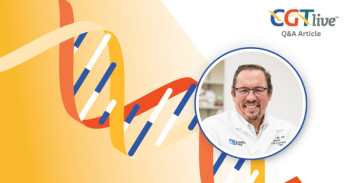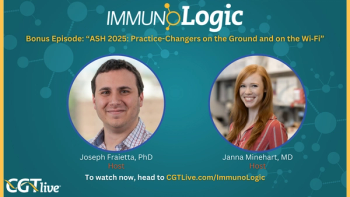
Liso-Cel Produces Clinically Meaningful Activity in Patients With R/R MCL With Wide Range of Prior Lines of Therapy
The subgroup analysis also looked at safety outcomes.
Bristol Myers Squibb’s lisocabtagene maraleucel (liso-cel, marketed as Breyanzi), an autologous CD19-directed chimeric antigen receptor (CAR) T-cell therapy, has demonstrated the ability to produce clinically meaningful activity in patients with relapsed/refractory (r/r) mantle cell lymphoma (MCL) regardless of the number of prior lines of therapy received. The data comes from a post hoc subgroup analysis that was presented in a poster at
The analysis included patients who were treated with liso-cel in the MCL cohort in the phase 1 TRANSCEND NHL 001 clinical trial (NCT02631044). Among the 81 patients who had received liso-cel after 2 or more prior lines of the therapy, the overall response rate (ORR) was 83% (95% CI 72.7-90.2) (n=67) and the complete response (CR) rate was 72% (95% CI 60.5-81.1) (n=58). Among the 29 patients in this group who had received either 3 or 4 lines of prior therapy, the ORR was 86% (95% CI 68.3-96.1) (n = 25) and the CR rate was 72% (95% CI 52.8-87.3) (n = 21) and among the 26 patients who had received 5 to 11 prior lines of therapy the ORR was 81% (95% CI 60.6-93.4) (n = 21) and the CR rate was 65% (95% CI 44.3-82.8) (n = 17).
The study also looked at results based on whether patients’ disease had been refractory to prior treatment with a Bruton tyrosine kinase inhibitor (BTKi). Among the 35 patients who had disease that was not refractory to the BTKi, the ORR was 91% (95% CI 76.9-98.2) (n = 32) and the CR rate was 80% (95% CI 63.1-91.6) (n = 28). Among the 45 who had disease that was refractory to the BTKi, the ORR was 76% (95% CI 60.5-87.1) (n = 34) and the CR rate was 64% (95% CI 48.8-78.1) (n = 29).
Furthermore, among patients who had received 2 or more lines of therapy, the median duration of response (DOR) was 14.5 months (m) [95% CI 5.7-not reached (NR)], the median progression free survival (PFS) was 12.3m (95% CI 6.5-NR), and median overall survival (OS) was 17.1m (95% CI 11.1-36.3). For the patients who received 3 to 4 prior lines of therapy, the median DOR was 17.5m (95% CI 3.3-NR), the median PFS was 16.6m (95% CI 2.6-NR), and the median OS was 18.4m (95% CI 6.7-NR) and for the patients who received 5 to 11 prior lines of therapy the median DOR was 6.7m (95% CI 2.4-15.8), the median PFS was 7.4m (95% CI 3.3-12.3), and OS was 13.5m (95% CI 9.5-17.1). For patients whose disease was not refractory to prior treatment with a BTKi, the median DOR was 24m (95% CI 7.6-NR), the median PFS was 24m (95% CI 8.6-NR), the median OS was 36.3m (95% CI 15.3-NR) and for patients whose disease was refractory to prior treatment with a BTKi the median DOR was 5.3m (95% CI 2.3-15.8), the median PFS was 6.1m (95% CI 3.1-16.5), and the median OS was 11.1m (95% CI 6.1 to 17.1).
The safety analysis included several additional patients who were not included in the efficacy analysis. Grade 1-2 cases of cytokine release syndrome (CRS) were reported in 52 of 85 (61%) patients who received at least 2 prior lines of therapy, in 20 of 31 (65%) patients who received 3 to 4 prior lines of therapy, in 18 of 26 (69%) patients who received 5 to 11 prior lines of therapy, in 20 of 36 (56%) patients whose disease was not refractory to their BTKi, and 30 of 47 (64%) patients whose disease was refractory to their BTKi. Although, grade 3-4 cases of CRS were only seen in 1 patient in the overall population. The patient had received 3-4 prior lines of therapy and had disease that was not refractory to the BTKi. Grade 1-2 cases of neurological events (NEs) occurred in 19 (22%) patients who had received at least 2 prior lines of therapy, 7 (23%) patients who had received 3 to 4 prior lines of therapy, 5 (19%) patients who had received 5 to 11 prior lines of therapy, 6 (17%) patients who disease was not refractory to the BTKi, and 12 (26%) patients whose disease was refractory to the BTKi. Grade 3-4 cases of NE were reported in 7 (8%) patients who had received at least 2 prior lines of therapy, 3 (10%) patients who had received 3 to 4 prior lines of therapy, 2 (8%) patients who had received 5 to 11 prior lines of therapy, 2 (6%) patients whose disease was not refractory to the BTKi, and 5 (11%) patients whose disease was refractory to the BTKi. First author M. Lia Palomba, MD, a hematologic oncologist at Memorial Sloan Kettering Cancer Center, and colleagues also pointed out that there were more cases of some types of cytopenias in patients who had received 5 or more prior lines of therapy than in the patients who had received fewer than 5 lines of prior therapy.
“In subgroup analyses by number of prior lines of systemic therapy and by response to prior BTKi therapy, clinically meaningful activity was demonstrated across all subgroups,” Palomba and colleagues concluded. “Median DOR, PFS, and OS were numerically higher in patients who had received less than 5 prior lines of systemic therapy and those with disease not refractory to prior BTKi. Low incidence of severe CRS or NEs regardless of number of prior lines of systemic therapy or response to prior BTKi were observed, with no grade 5 CRS or NEs reported in any subgroup. Liso-cel cellular kinetics were generally consistent with the overall population across most subgroups, but numerically lower median Cmax and AUC(0-28d) were observed in patients with 5 or more prior lines of systemic therapy and those refractory to prior BTKi. The better efficacy and safety profile observed in patients with r/r MCL who received less than 5 prior lines of therapy and those with disease not refractory to prior BTKi support the use of liso-cel in earlier lines of therapy.”
REFERENCES
1. Palomba ML, Siddiqi T, Gordon LI, et al. Subgroup analyses in patients with r/r MCL treated with lisocabtagenemaraleucel by prior lines of therapy and response to bruton tyrosine kinase inhibitor from the TRANSCEND NHL 001 MCL cohort. Presented at: the European Hematology Association (EHA) 2024Hybrid Congress, June 13-16, held both virtually and in Madrid, Spain. Abstract #P1126
Newsletter
Stay at the forefront of cutting-edge science with CGT—your direct line to expert insights, breakthrough data, and real-time coverage of the latest advancements in cell and gene therapy.





































